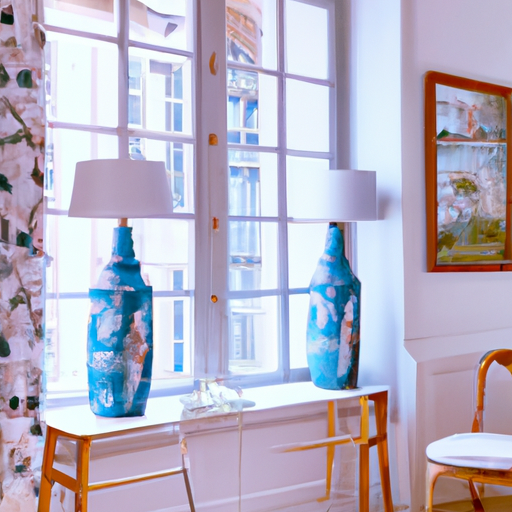Exploring Unique Wall Treatments for a Bold Architectural Statement
Creating architectural interest in your home is an excellent way to elevate its aesthetic appeal and make a bold statement. One of the most effective ways to achieve this is by exploring unique wall treatments that can transform your living space into a work of art. In this article, we will discuss various wall treatment options that can help you create a visually stunning and architecturally interesting home.
One of the most popular wall treatments for creating architectural interest is the use of textured paint. Textured paint can be applied to walls in a variety of ways, including using a brush, roller, or trowel. This type of paint is designed to create a textured surface that adds depth and dimension to your walls. Some popular textured paint techniques include stippling, rag rolling, and sponge painting. These techniques can be used to create a variety of effects, from subtle texture to bold, dramatic patterns.
Another option for creating architectural interest with wall treatments is the use of wallpaper. Wallpaper has come a long way in recent years, with many modern designs featuring bold patterns, textures, and colors. Some wallpapers even mimic the look of natural materials, such as wood, stone, or brick, allowing you to create the illusion of architectural features without the need for costly renovations. Additionally, removable wallpaper options are available, making it easy to change the look of your space without damaging your walls.
For those looking to make a truly bold statement, consider using a wall mural to create architectural interest. Wall murals can be custom-designed to fit your specific space and can feature anything from abstract patterns to realistic landscapes. This type of wall treatment can create a stunning focal point in your home and is sure to impress guests. If you’re not ready to commit to a full wall mural, consider using decals or stencils to create a similar effect on a smaller scale.
Another unique wall treatment option is the use of decorative panels. Decorative panels can be made from a variety of materials, including wood, metal, and acrylic. These panels can be used to create a variety of effects, from geometric patterns to intricate, ornate designs. Some decorative panels even feature built-in lighting, adding an extra layer of visual interest to your walls. This type of wall treatment can be used to create a focal point in a room or to add architectural interest to an otherwise plain wall.
Finally, consider using architectural molding to create interest on your walls. Architectural molding can be used to create a variety of effects, from simple, clean lines to elaborate, ornate designs. This type of wall treatment can be used to frame artwork, create a border around a room, or add depth and dimension to your walls. Some popular types of architectural molding include crown molding, chair rail molding, and baseboard molding.
In conclusion, there are numerous unique wall treatment options available for those looking to create architectural interest in their homes. From textured paint and wallpaper to wall murals and decorative panels, these treatments can transform your living space into a visually stunning and architecturally interesting environment. By exploring these options and experimenting with different techniques, you can create a home that reflects your personal style and makes a bold architectural statement.
Incorporating Exposed Beams and Structural Elements for a Rustic Charm

Exposed beams and structural elements have long been a popular design feature in homes, adding a touch of rustic charm and architectural interest to any space. Whether you’re renovating an old farmhouse or looking to add character to a modern home, incorporating exposed beams and other structural elements can create a unique and inviting atmosphere. In this article, we’ll explore some of the ways you can use these features to enhance your home’s design and create a space that’s both functional and aesthetically pleasing.
One of the most common ways to incorporate exposed beams into your home is by using them as a decorative element in your ceiling. This can be achieved by either exposing the existing beams in your home or by installing new ones. If you’re working with an older home, you may be lucky enough to have original beams that can be uncovered and restored. This can involve removing any plaster or drywall that’s covering the beams, sanding them down, and applying a finish to protect the wood and enhance its natural beauty.
If your home doesn’t have existing beams, or if you’re looking to add more architectural interest to a specific room, you can install faux beams made from lightweight materials like polyurethane or reclaimed wood. These beams can be attached to your ceiling using brackets or other hardware, and can be painted or stained to match the rest of your home’s decor. Faux beams are a great option for homeowners who want the look of exposed beams without the added weight and structural concerns that come with real wood.
Another way to incorporate exposed beams and structural elements into your home is by using them as a focal point in your design. This can be achieved by creating a feature wall with exposed brick or stone, or by using large wooden beams to frame a fireplace or other architectural feature. By drawing attention to these elements, you can create a sense of depth and dimension in your space, making it feel more dynamic and visually interesting.
In addition to adding visual interest, exposed beams and structural elements can also serve a functional purpose in your home. For example, you can use beams to create a sense of separation between different areas of an open-concept living space, or to provide support for a loft or mezzanine level. By incorporating these features into your home’s design, you can create a space that’s both beautiful and practical.
When incorporating exposed beams and structural elements into your home, it’s important to consider the overall style and aesthetic you’re trying to achieve. If you’re going for a rustic, farmhouse-inspired look, you may want to use reclaimed wood beams and other natural materials to create a warm, cozy atmosphere. On the other hand, if you’re aiming for a more industrial or modern aesthetic, you might opt for sleek metal beams and exposed concrete or brick.
Regardless of the style you choose, it’s essential to ensure that the exposed beams and structural elements you incorporate into your home are properly installed and maintained. This may involve working with a structural engineer or contractor to ensure that your home can support the added weight of the beams, as well as regularly inspecting and maintaining the beams to prevent damage or decay.
In conclusion, incorporating exposed beams and structural elements into your home can add a touch of rustic charm and architectural interest to any space. By carefully considering the style and function of these features, you can create a unique and inviting atmosphere that’s both visually appealing and practical. Whether you’re restoring an old farmhouse or adding character to a modern home, exposed beams and structural elements can help you achieve the look and feel you desire.
Designing Custom Built-ins and Storage Solutions for a Functional and Stylish Space
Creating architectural interest in your home is an essential aspect of interior design that can elevate the overall aesthetic and functionality of your living space. One of the most effective ways to achieve this is by designing custom built-ins and storage solutions that not only cater to your specific needs but also add a touch of sophistication and style to your home. In this article, we will explore various ways to create architectural interest through custom built-ins and storage solutions, ensuring that your home is both functional and visually appealing.
To begin with, it is crucial to assess your storage needs and determine the areas in your home that require additional storage or organization. This could include anything from a cluttered living room to a cramped kitchen or an underutilized hallway. Once you have identified these areas, you can start brainstorming ideas for custom built-ins and storage solutions that will not only address your storage needs but also enhance the overall design of your home.
One of the most popular and versatile custom built-in options is the classic bookshelf. A well-designed bookshelf can serve as a focal point in any room, showcasing your personal library while also providing ample storage for decorative items, photographs, and other personal belongings. To create architectural interest, consider incorporating unique design elements such as asymmetrical shelving, contrasting materials, or built-in lighting. These features can transform a simple bookshelf into a stunning statement piece that adds depth and character to your space.
Another effective way to create architectural interest through custom built-ins is by designing a window seat or bench. This not only adds additional seating to your home but also provides an opportunity to incorporate hidden storage beneath the seat. A window seat can be designed to complement the existing architecture of your home, with features such as decorative molding, paneling, or custom upholstery. Additionally, a window seat can serve as a cozy reading nook or a comfortable spot to enjoy a cup of coffee while taking in the view outside.
In the kitchen, custom cabinetry and storage solutions can significantly improve the functionality and aesthetic of the space. Consider designing a built-in pantry or appliance garage to keep your countertops clutter-free and organized. Custom cabinetry can also be designed to accommodate specific storage needs, such as a pull-out spice rack, a built-in wine rack, or a designated spot for your favorite kitchen gadgets. By incorporating these custom features, you can create a kitchen that is not only visually appealing but also tailored to your specific needs and preferences.
Finally, don’t overlook the potential of underutilized spaces in your home, such as hallways, staircases, or awkward corners. These areas can be transformed into functional and stylish storage solutions with the help of custom built-ins. For example, a staircase can be fitted with pull-out drawers or shelves to create additional storage for shoes, linens, or seasonal items. Similarly, a narrow hallway can be enhanced with a custom console table or floating shelves, providing a space to display artwork, photographs, or decorative items.
In conclusion, designing custom built-ins and storage solutions is an effective way to create architectural interest in your home while also improving its functionality and organization. By carefully considering your specific needs and incorporating unique design elements, you can create a living space that is both stylish and practical. Whether it’s a statement-making bookshelf, a cozy window seat, or a well-organized kitchen, custom built-ins can elevate the overall aesthetic of your home and make it truly one-of-a-kind.
Q&A
Question 1: What are some ways to create architectural interest in your home?
Answer 1: To create architectural interest in your home, consider incorporating unique design elements such as exposed beams, built-in bookshelves, decorative moldings, statement walls, and creative use of materials like reclaimed wood or metal. Additionally, play with different ceiling heights, add archways or columns, and use contrasting textures and colors to create visual interest.
Question 2: How can lighting be used to enhance architectural features in a home?
Answer 2: Lighting can be used to enhance architectural features by highlighting specific elements, creating depth, and setting the mood. Use accent lighting to draw attention to unique features like artwork, built-ins, or textured walls. Layer ambient, task, and accent lighting to create depth and dimension in a space. Consider installing dimmer switches to control the intensity of light and create different moods.
Question 3: How can the choice of furniture and decor contribute to architectural interest in a home?
Answer 3: Furniture and decor can contribute to architectural interest by complementing and accentuating the existing design elements in a space. Choose pieces that reflect the architectural style of your home, such as modern furniture for a minimalist space or antique pieces for a traditional setting. Use furniture to create focal points, define spaces, and add visual interest through color, texture, and shape. Additionally, incorporate statement pieces like large-scale artwork or sculptural elements to create a sense of drama and intrigue.
Conclusion
In conclusion, creating architectural interest in your home involves incorporating unique design elements, playing with scale and proportion, using contrasting materials and textures, and adding focal points. By thoughtfully combining these aspects, homeowners can transform their living spaces into visually appealing and engaging environments that reflect their personal style and enhance the overall aesthetic of their homes.


